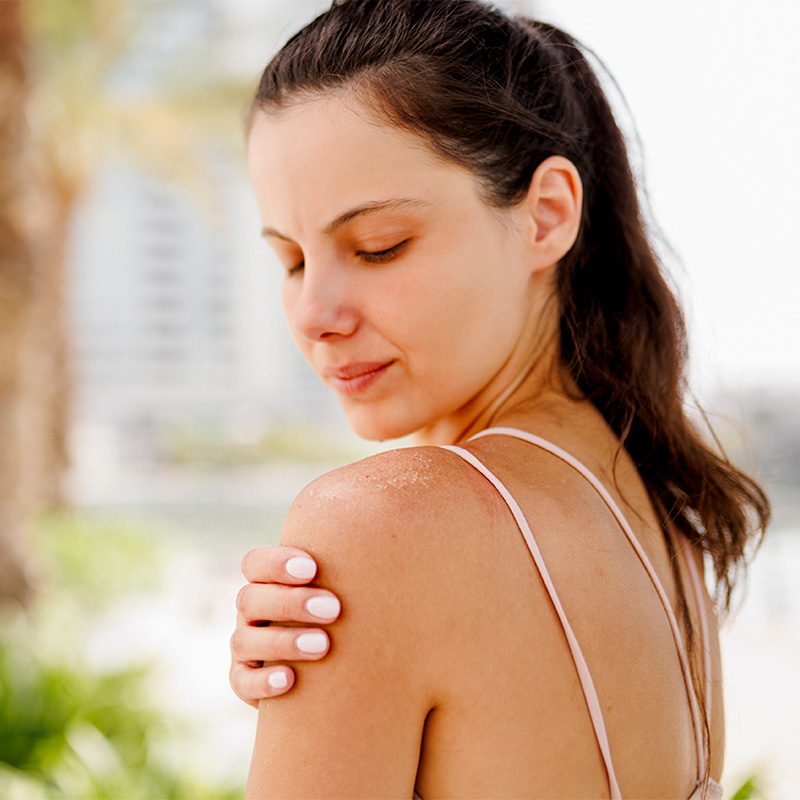Understand seborrheic dermatitis with our expert guide. Learn about its symptoms, causes, and effective treatments. Discover tips for managing this common skin condition and maintaining healthy skin.
Normal, dry to atopic skin
Reading time : 5 min

Understand seborrheic dermatitis with our expert guide. Learn about its symptoms, causes, and effective treatments. Discover tips for managing this common skin condition and maintaining healthy skin.
Seborrheic dermatitis is a common skin condition, non-contagious and harmless to your health. It can easily be managed with treatment.
Seborrheic dermatitis is a chronic skin condition that affects your scalp and can occur in other parts of the body. It is noncontagious and an easy-to-manage skin condition.
It is a chronic type of eczema also called dandruff, seborrheic eczema or seborrheic psoriasis.
Seborrheic dermatitis is a common skin condition which affects about 11% of the population in the US. It can appear in people of all ages but men between the age of 30 to 60 are more likely to develop the condition. It is especially common in adults of 50 years old and older.
Seborrheic dermatitis can also appear in infants younger than three months.
People with history of psoriasis in the family or prone to oily skin are more likely to have psoriasis dermatitis.
Also, the following causes can have an impact on seborrheic dermatitis apparition:
Immunosuppression: organ transplant, HIV for example
Psychiatric disorders: depression
Neurological diseases: Parkinson, epilepsy, etc.
Congenital disorders: Down syndrome
Psychotropic medications: lithium, buspirone
Researchers are not sure of the exact cause of seborrheic dermatitis, but main risk factors include:
Stress
Cold and dry climate
Alcohol-based lotions
A type of yeast called Malassezia
Increased level of androgens hormone
Increased level of skin lipid
Inflammatory reaction due to a problem in the immune system
Other causes can worsen seborrheic dermatitis like the frequent use of hot water or food containing yeast and mold like cheese, bread, wine and beer.
Seborrheic dermatitis is an easy disease to diagnose because of its symptoms. By looking at your skin, your dermatologist should be able to diagnose the condition. He may perform a skin biopsy to exclude other skin conditions.
Seborrheic dermatitis may be caused by an immune reaction to a microscopic fungus called Malassezia. This yeast is present on all healthy skin, but some people can develop an immune reaction to Malassezia for unclear reasons. This immune response could trigger seborrheic dermatitis in some cases.
Seborrheic dermatitis is not an allergy, it is a chronic condition triggered by different factors.
Even if certain habits and products can help reduce symptoms, it is necessary to see a doctor or dermatologist to find the right treatment. There is no cure for seborrheic dermatitis, but many treatments can help relieve itchiness and clear rashes.
Your health care provider might suggest antifungal gels, creams, lotions, foams or shampoos to limit the inflammation. There are two types of treatments including over-the-counter products and prescription products.
For scalp treatment, you can follow the next advice:
On babies, massage or brush the scalp with a soft brush after each shampoo and several time a day
Use a gentle steroid lotion
Use dandruff shampoos that contain selenium, zinc or coal tar or antifungal shampoos that contain ciclopirax or ketoconazole
For face and body treatment you can choose between:
Topical antifungals available in creams, foams or gels
Corticosteroids available in creams, lotions, foams, gels, ointments, oil or solution
Calcineurin inhibitors (alternative to corticosteroids) available in cream or ointment
Oral antifungals (for severe cases only)
Phototherapy (for severe cases only)
The condition improves quickly with regular treatment adapted to your condition. Always check with your dermatologist about the side effects of any prescribed treatment. Inappropriate treatment will result in flare-ups and worsen your symptoms. Avoid self-treatment as soon as the affected areas become painful and drain fluid.
Seborrheic dermatitis usually does not disappear on its own. It needs to be treated with a specific treatment depending on your symptoms and the area of the body affected. It is possible to have the disease for life with seasonal flare-ups occurring during winter and early spring. Flare-ups can also occur during big stress periods.
In babies, seborrheic dermatitis can go away on its own within a few months.
Hair loss is not common in seborrheic dermatitis. It is usually not a symptom of this skin condition.
Seborrheic dermatitis causes dry, yellowish, scaly patches on the scalp — and it could be causing it to smell, but only in rare cases. The most common symptoms are red and itchy skin on the scalp.
Seborrheic dermatitis cannot spread from one person to another. It is not a contagious disease.
The itching feeling is usually mild, but it can turn to be intense, especially on the scalp. Also, the itchy rash can lead to an infection without treatment. Seborrheic dermatitis usually causes no serious harm, but it can be a very discomfortable condition.
Seborrheic dermatitis is a very common condition which can easily be managed with specific treatment. By following your dermatologist’s instructions, you should avoid itchy skin and white flakes.